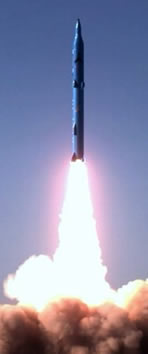
In a briefing at the Jerusalem Center for Public Affairs, Uzi Rubin, former head of Israel’s missile defense program and Israel Missile Defense Association (IMDA) Board of Directors member, presented an assessment of the Iranian ballistic missile program and its potential threat to Europe. “Iran is not sparing any effort to develop missiles reaching beyond 2000 kilometers,” said Rubin. “We can assume this push is derived from government policy and strategic objectives, rather than scientific enthusiasm.”
Iran’s missile scientists have graduated through the development of the indigenous Sejjil missile and they now possess all the technologies required for exploiting these capabilities. They currently reach many Asian and Eastern European capitals, and within 18 month time they could extend their reach covering the entire European continent” said Rubin. “Europe may not be threatened by Iran at present, but within a short time, European capitals could face the full weight of the Iranian threat – missiles loaded with nuclear weapons capable of reaching all major cities. “Rapid fielding of an effective missile defense in Europe is not an option, it is imperative.” Said Rubin.
Rubin’s claim contradicts a recent EastWest Institute (EWI) report claiming Iran does not possess ballistic missiles capable of reaching Europe, Rubin quoted the recent Iranian test launch of the Sejjil-2 missile, capable of carrying a warhead of 1,000 kg (representative to be the minimum weight of a nuclear missile warhead). While the Iranians claimed the missile could reach ‘beyond 2,000 km’, Russian sources have estimated its maximum to be 2,460 kilometers, reaching at least six NATO countries. Rubin indicated that with minor modifications to the Sejjil – Iran’s two-stage solid-propelled missile, Tehran can acquire a medium-range ballistic missile (MRBM) covering distances of 3,900 kilometers, reaching all European capitals including London, Paris, Madrid, Berlin and Rome. “Such a missile could use the same 5.78 ton second stage of the Sejjil, and a 1,000 kg warhead, with a 31.8 ton first stage, using slightly increased diameter (1.6 m’, compared to 1.2 m’ of the Sejjil’s). The overall height of the new missile could be 20 meters (compared to 18 of the Sejjil). Such a missile could be as survivable as the Sejjil, transported, stored and launched from hidden mountain-side silos that could store Sejjil-sized missiles.
From information made available through open sources, Rubin assessed, that despite the sanctions imposed on technology transfer, especially regarding missile technologies (MTCR), Iran has managed to surpass the technological levels sofar obtained from North Korea. ‘The student has excelled over the teacher’ said Rubin. “through the past 24 months Iranian scientists and engineers have acquired and mastered all the key technologies required for their ballistic missile programs” said Rubnin, “Within 12-24 months the Iranian engineers have successfully implemented new propulsion technologies indigenously developed in country, reaching mature state of these complex programs.” Said Rubin. In recent years the Iranian missile developers have managed three parallel programs – liquid-fuelled ballistic missiles, solid propelled ballistic missiles and satellite launchers; “in all three programs the Iranian engineers demonstrated a high level of proficiency, despite encountering failures and they have learned from initial failures, effectively acquired and analyzed flight test data to understand the problems, fixed what had to be corrected, resulting in subsequent successful tests” Rubin said.
Sejjil 2 missile carried on its transporter, erector, launcher (TEL) on the military parade in Tehran, September 2009. Photo: FARS news agency

















